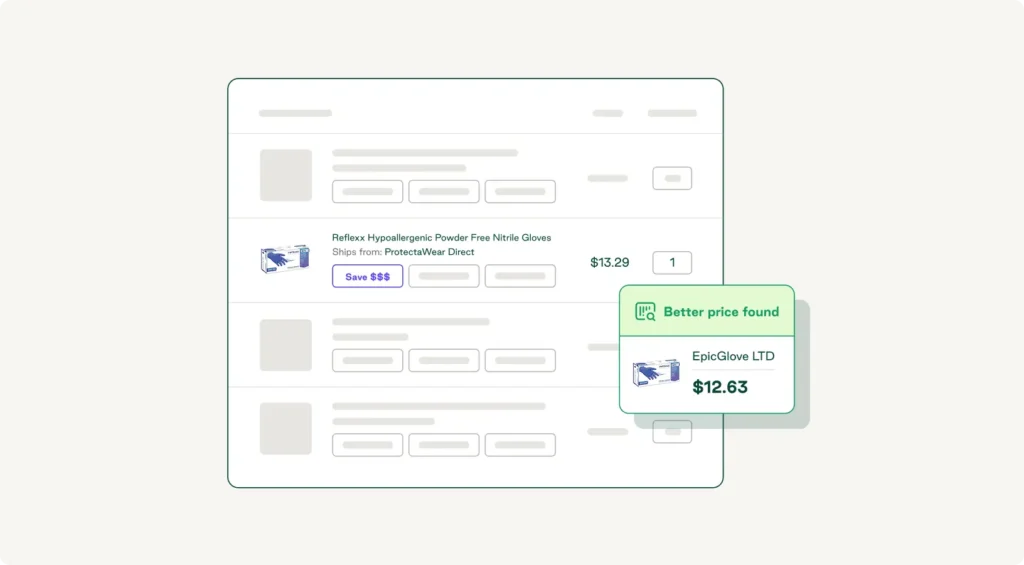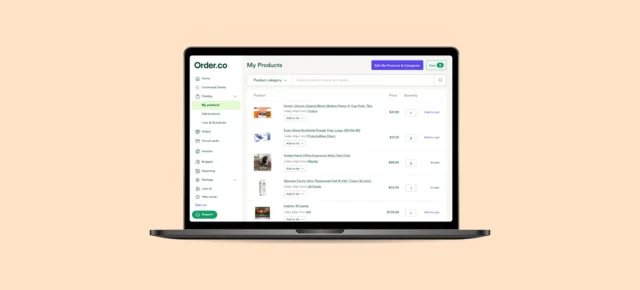5 Manual Processes Procurement Automation Should Replace

5 Manual Processes Procurement Automation Should Replace
Manual procurement processes may work on a small scale. But as your business grows, they can create bottlenecks that decrease productivity and increase costs. Issues like invoicing errors, maverick spending, and over-budgeting can accumulate, making it increasingly difficult to correct core procurement problems.
Automation addresses these challenges by minimizing manual tasks within accounts payable. It also enables spend controls and approval workflows, giving you a comprehensive view of each purchase and action within your procurement department. These improvements help you save time, cut costs, and align your procurement strategy with overall business goals.
This guide explains how procurement automation can lower costs, provide real-time analytics, and create a more efficient procurement cycle.
Download the free ebook: The Procurement Strategy Playbook for Modern Businesses
What is procurement automation?
Procurement automation is the process of leveraging technology to minimize repetitive, manual tasks across all your procurement workflows, optimizing everything from approvals to payments. Automation systems help you gain control over your supply chain, beginning with requisitions and orders through to fulfillment and invoice processing.
To implement procurement automation, adopt a modern procurement platform or procure-to-pay software that enforces spend controls, automates approval workflows, and records all transactions and tasks into one centralized system.
Why should you automate your procurement process?
Leveraging procurement process automation helps your company save time and money. Automating everything from sourcing to spend management and invoice processing can improve efficiency, increase cost savings, and simplify the entire purchasing process. By freeing up time and resources, automation can give team members the bandwidth to tackle more important tasks that fuel growth.
Here are the top benefits of procurement automation.
Optimized costs
Procurement automation tools boost cost efficiency by reducing manual labor and associated expenses. Rather than adding headcount to handle increased procurement volume, the system scales as your company grows and expands. Automated solutions also improve communication between buyers and suppliers, resulting in more efficient purchasing.
For example, a leading wholesale distributor used Order.co to recover over $8,000 in one year. By consolidating its procurement operations into a single platform, the company overcame fragmented purchasing and a lack of visibility, unifying operations and cutting ordering time in half.
Increased accuracy
Modern procure-to-pay technology optimizes invoice processing and prevents costly human errors, such as manual data entry mistakes, duplicate payments, or missed invoices. By replacing manual tasks with standardized digital workflows, process automation increases control and oversight of every transaction.
Automation enhances accuracy using:
- Approval workflows: Configure automatic approvals by vendor, location, or total cost to enforce compliance and prevent overspending.
- Spending controls: Set budgets by user or supplier and receive instant alerts when spending exceeds these limits.
- In-depth reporting: Automatically generate reports on spend, budgets, user activity, and historical data for trend analysis.
- 3-way matching: Match purchase orders, invoices, and receipts to eliminate manual reconciliation and reduce fraud risk.
Reduced risk
Automation increases transparency across the purchasing process, enabling more consistent supplier evaluation and better strategic sourcing decisions. With a centralized system, your team can prioritize approved vendors and reduce exposure to fraud or noncompliance. Over time, automated tracking and performance data help identify underperforming suppliers and proactively mitigate sourcing risks.
Faster processing
When you automate procurement processes, you can significantly boost efficiency. With automation, you can quickly conduct:
- Analyses: Compare prices from various vendors to find the best value.
- Policy reviews and spend verifications: Track approvals and budget limits across multiple departments.
- End-to-end procurement tasks: Automate ordering, reconciliation, payment, and spend management reporting.
Automating these processes accelerates procurement by shortening cycle times and reducing the burden on accounts payable.
For example, AvantStay, a hospitality platform, uses Order.co to automate procurement and improve tracking. Jack Langenhorst, associate director for supply chain and onboarding, notes that Order.co has helped with “...tracking, if we need to return items, or there’s a discrepancy.” Langenhorst highlights the efficiency of automated processes, saying, “It just helps save our team time.”
How to prioritize high-impact automation opportunities
Not every procurement task should be automated. Your team’s expertise will always be essential for making strategic procurement decisions, managing spend, and nurturing vendor relationships. However, since certain repetitive tasks can benefit from automation, identifying those opportunities can improve your procurement performance.
Use the steps below to evaluate and prioritize automation opportunities within your procurement cycle.
Map your process
Start by mapping your procurement workflow to uncover bottlenecks and error-prone steps. These are often strong candidates for automation.
When Zachary Garippa co-founded Order.co, he assessed the state of procurement as part of his process, identifying numerous inefficiencies within the industry. “We saw teams doing heroic amounts of manual work just to manage basic purchasing,” Garippa explained. After identifying those pain points, his team used artificial intelligence to transform slow, manual processes into automated workflows.
Just as Garippa evaluated procurement inefficiencies at an industry level, you can map yours at an organizational level to identify:
- Manual tasks that would benefit from automation
- Average time per task
- Process volume
- Error frequency
- Bottlenecks or delays
Add up your automation opportunity score
Once you've mapped your process and gathered data, the next step is to assign each process an automation opportunity score. A higher opportunity score signals greater potential ROI, helping you decide which processes to automate first. While this score isn’t a KPI, it provides a practical framework to compare processes and pinpoint where automation could deliver the biggest impact.
Here’s a breakdown of key information you’ll need:
- Process volume: How often your team performs the task
- Average time spent: How long it takes to complete manually
- Error rate: How often mistakes occur
- Automation difficulty: A ranking of 1 (very easy) to 5 (very hard)
Once you have your information, plug it into this formula:
Automation Opportunity Score = (Process Volume × Average Time Spent × Error Rate) /
Automation Difficulty
Keep in mind that the score does not have a cap—the higher the number, the stronger the signal that automation may be worthwhile.
Now, use the score to build comparative categories:
- High score + low difficulty = fast wins (ideal for automating first)
- High score + high difficulty = longer-term goals (require methodical planning)
- Low score + low difficulty = quick wins but minor impact (not a priority but good for small improvements)
- Low score + high difficulty = low impact and difficult to automate (not worth automating)
Example: A medical cannabis retailer uses a manual process for purchase verification, including three-way matching, for the highly regulated industry. It has 8 stores with 12 consolidated invoices per year (96 total), and each audit takes 5 labor hours and has a .05 error rate. Automation difficulty is 4 out of 5.
Automation Opportunity Score = (96 × 5 × .05) / 4
= 24 / 4
= 6
Once you've calculated scores for other manual tasks, you can compare them to see which areas offer the best potential automation value.
Verify your cost savings
After generating your scores and shortlisting the workflows you might want to automate, use this formula to analyze ROI:
Cost Savings % = ((Manual Cost – Automation Cost) / Manual Cost) × 100
Example: Manual cost for the cannabis retailer performing invoice matching is $14,400 ($30/hour wages), and automation cost is $12,000 per year:
((14,400 – 12,000) / 14,400) × 100
= (2,400 / 14,400) × 100
= 16.7%
This equates to a 16.7% estimated cost savings from automation—not including reduced manual errors and improved efficiencies.
By combining process mapping, automation opportunity scores, and cost savings analysis, your procurement team can prioritize automation opportunities to save money and boost productivity.
Top 5 procurement processes every company must automate
End-to-end procurement automation helps you gain more value from your procurement process while reducing time and resource demands. Automating processes like purchasing workflows, risk audits, and supplier performance measurement can offer a significant return on investment.
1. Purchase requisition and approval
Manual purchase requisitions and approvals result in inefficient purchasing workflows and a weak security review process. But when you introduce an automated system, your team can route purchase requests through a curated supply catalog or form. This removes the need for procurement or finance teams to route and track requests manually.
The request then moves automatically through departmental reviews:
- Department head: Confirms the request meets budget allocation, strategic alignment, and operational priorities. Preapproved items, vendors, and budgets can eliminate many of these steps.
- Legal: Reviews vendor contracts, terms and conditions, and regulatory compliance. Automation helps maintain accurate records and ensure compliant processes for easier reporting and auditing.
- Security: Verifies data privacy compliance with controlled access and authentication built into the platform.
- Finance: Confirms budget availability, payment terms, and overall financial impact. Automation platforms can help you create spend reports and unify your financial visibility.
Each approver interacts with the request directly in the system, ensuring it moves to the next stakeholder without time-consuming back-and-forth delays. Automating the approval process can cut days or weeks off time-to-close, ensuring faster and more efficient processes for procurement professionals.
2. Sourcing
If organizations don’t create an efficient sourcing process, stakeholders may select suppliers themselves. Automating sourcing allows buyers to get what they need while staying within procurement policies.
Procurement automation software centralizes preferred vendors for every purchase category, keeping buyers compliant and reducing maverick spend. It also creates necessary guardrails for self-service buying, including spending limits by role, user, department, spend category, and more.
By automating sourcing, you can also consolidate vendors for better deals. The right platform can automatically compare prices for the products you already purchase and leverage collective buying power to lower costs.

3. Invoice management
Invoices are one of the most common logjams in procurement. Teams using manual processing can only handle a certain number of invoices per day, especially considering that errors and exceptions take time to research and correct.
Automating invoice processing allows organizations to process hundreds or even thousands of invoices daily. Automated systems can:
- Digitize paper invoices
- Centralize data for every vendor and purchase
- Automatically check and reconcile invoices against databases
- Ensure accurate coding so your accounting system acts as a single source of truth
This eliminates missed payments, duplicate invoices, miscoded purchases, and other costly errors.
4. Payments
As with invoicing, manual payment processing creates delays, increases data entry errors, and raises the risk of vendor fraud.
Payment automation allows your accounts payable team to process payments quickly and accurately while storing data for reporting activities like month-end close and financial audits. This gives AP real-time visibility into payments to help reduce issues and unlock benefits like early payment discounts. Automated systems also support procurement audits by connecting invoices, transactions, deliverables, and vendor satisfaction data into a clear, actionable view of procurement health.
5. Contract management
Executing a contract is only the beginning. Once signed, the ongoing work of monitoring and enforcing it begins.
Relying on manual contract management is expensive, lacks visibility, and makes tracking compliance and deadlines difficult. Effective contract management ensures pricing and terms remain competitive, strengthens supplier relationships, and maintains consistent quality in procured goods and services.
Automating contract management with a centralized system is the most efficient way to achieve these outcomes. Automation enables notifications and updates so you always know when contracts are up for renewal and have ample lead time to evaluate and negotiate new terms.
A roadmap for implementing procurement automation
Implementing procurement automation can feel daunting, but breaking it into manageable steps makes the entire process more approachable. Here’s how to get started on your automation initiatives.
Discovery: Decide which platform you want to use for automation. Order.co, for example, provides automatic audit trails, payment capabilities, reporting, and three-way matching—along with savings from leveraging bulk buying.
Next, select a specific procurement activity to automate, such as pre-coding invoices to provide clear spend data and reporting.
- Action tip: Try a demo of a procurement automation platform to explore opportunities first-hand.
Pilot: Test the waters with a small group to see how it improves your process. Begin by working with a limited number of top-performing employees to troubleshoot the software and your workflows.
- Action tip: Use the pilot to identify friction points. Write down frustrations and questions so you can smooth implementation for the broader organization.
Rollout: Launch the new automation process across the entire team, providing thorough onboarding and training. Follow leadership expert John Maxwell's method: Do a step yourself, work on it together, and then let the team member do it on their own.
- Action tip: Share early wins during rollout to get everyone excited and motivate them to try new use cases.
Feedback: Collect first impressions, concerns, and lingering questions to refine the automation process. Hold meetings, analyze automation progress, and send out surveys to gather valuable insights.
- Action tip: Communicate ongoing progress and address friction points with short how-to videos or detailed process guides that team members can reference as needed.
The best software tools for procurement automation
The procurement system you choose has a direct impact on your automation outcomes. With a platform like Order.co, you get the flexibility to meet your unique business needs plus the structure necessary to build efficient workflows that reduce costs and increase productivity.
Order.co's procurement software solution provides key features like:
- Flexible setup: Create custom workflows that match your business processes
- Automatic general ledger (GL) coding: Ensure accuracy in accounting
- Vast vendor access: Connect with thousands of suppliers, track favorites, and review order history
- Dynamic permissions: Support multiple user tiers, roles, and responsibilities
- Centralized contract information: Simplify vendor management and reporting
See Order.co’s procurement automation in action—schedule a demo to experience end-to-end workflow automation from requisition to payment.
Get started
Schedule a demo to see how Order.co can simplify buying for your business.
"*" indicates required fields



